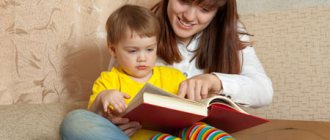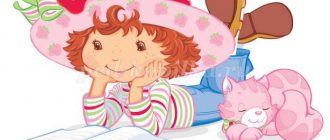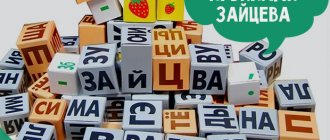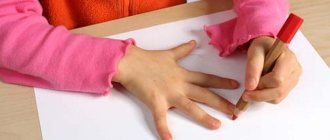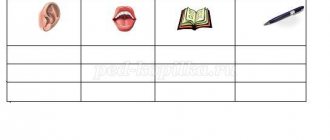Every parent who cares about their harmonious, correct and holistic development thinks about the importance and role of reading in the life of their children. But if in some families it is enough for mothers and fathers to simply send their child to kindergarten or school, shifting, without it sounding too loud, the responsibility onto the shoulders of educators and teachers, then in others caring parents prefer to work with their children on their own.
The information from this course is intended specifically for people of the second category, because those who belong to the first are unlikely to search for relevant information on the Internet. But let's continue.
Despite the great desire to teach your precious child to read as soon as possible, this process should be approached with maximum attention and caution, because there are subtleties and nuances here that you simply cannot turn a blind eye to. The fact is that, contrary to the popular belief that the sooner you start learning the basics of reading with your child, the better, many specialists (neurologists, child psychologists, etc.) are convinced that this can lead to negative consequences in the future. For example, early learning to read with accompanying premature loads on the visual system often becomes the cause of myopia and other vision problems.
Thus, it is very important to know at least the basic features of the formation of a child’s body, when to start teaching children to read and how their readiness for this process is determined, as well as to adhere to the basic relevant rules. These fundamental questions will be discussed in the first lesson.
How a child is formed. general information
Here, as you should understand, we will present only general information, because... it will be quite enough.
So, starting from the early stages of pregnancy and ending at the age of three, the first functional block of the baby’s brain is formed, which is responsible for his bodily, cognitive and emotional perception.
From three to five to eight years, the formation of the second functional block of the brain occurs, which controls the five senses - touch, taste, smell, hearing and vision.
As for conscious mental activity, it develops in a period of approximately seven to fifteen years.
It should be borne in mind that the formation of functional brain blocks is a sequential process. Any attempt by a parent to “skip” any stage negatively affects the natural development of the child, because unnatural “adjustments” are made to it. The insidiousness of the consequences lies in the fact that, quite likely, they will not be felt immediately, but over the years. Subsequently, an already matured child may develop problems, expressed not only in speech disorders, neuroses, motor disturbances, etc., but also in difficulties in relationships with other people.
Based on this, you need to start teaching your child to read at a certain time.
When can you start teaching your child to read?
There are several opinions about when you can start teaching your child to read. Some experts believe that you can start certain work, for example, showing Doman cards (we will talk about them and other methods in the second lesson), when the baby reaches six months of age, while others believe that it is best to start at 3-4 years , and precisely from the ABC book. However, all teachers agree on one thing: no teaching of reading is completely unacceptable and impossible until the child has mastered speech skills. If, around the age of 3-4, the child begins to take an active interest in books, it is not only possible, but also necessary to begin learning to read.
It is also worth noting that if you show restlessness and indifference to printed materials, before learning, you should understand how to arouse the child’s interest in reading. We will touch on this issue in more detail in a separate lesson, but we will still say that in solving this problem, parents will be helped by an incredible selection of books that stand out, in addition to brightness and colorfulness, by the presence of many moving elements and even sound. Thanks to this, reading becomes not just an interesting activity for children, but also an exciting game. At the initial stage, any book serves not so much as a source of knowledge, but as a way to become familiar with the reading process itself.
Continuing the conversation on the topic of a child’s readiness to read, it can be determined by several criteria:
- Firstly, the baby has already formed speech, and he is able to pronounce words and sentences, as well as compose at least small coherent stories
- Secondly, the child does not have speech therapy disorders, and this applies to both incorrect pronunciation and violations of the melody and tempo and rhythm of speech
- Thirdly, the baby is able to navigate normally in space, and does not confuse the concepts of “right”, “left”, “down” and “up” with each other.
- Fourthly, the child has sufficiently developed phonemic hearing, i.e. he can easily recognize sounds in different parts of words
If problems are observed with any of the above, you should begin to eliminate them - spend some time working on the issues causing difficulty, visit a speech therapist, neurologist, etc. If everything is in order (or after the problems have been eliminated), you can move on to learning to read.
Series of didactic games “Learning to Read”
Elena Milokhina
Series of didactic games “Learning to Read”
Our children have many different ABC books with colorful bright pictures. Kids quickly remember letters and match pictures to each letter. How interesting it is for a child and mother to flip through the first pages of the Primer, study and memorize the letters. But now there are already several letters in stock and it’s time to combine them into syllables. For some children this happens quite easily and quickly. Others find this connection difficult. The two letters don’t connect in any way, the word doesn’t come out. And then, even if you turn the pages or don’t turn the pages, reading will not work. The child sighs heavily, the mother is upset. What to do? Stay. Do not hurry. Put the Primer aside for a while. Play with the letters a little more. Give the child the opportunity to understand how two letters are connected to form a syllable?
Every teacher has wonderful games to help them. With the help of these games, the child gradually masters the difficult process of merging two letters to form a straight syllable (MA, PO, TU). I also use games in my practice that both children and adults enjoy. The most important thing is that when playing such games, the child does not sigh over every syllable and does not worry. Games are made easily and simply.
Game "Syllable Ladder"
For the ladder, a Lego constructor is used. On a separate cube, consonant letters are glued on all four sides. A little man is attached to the top of this cube. This is Bukvarenok. The child places the Bukvarenka on each step of the ladder and names a song syllable (AM OM UM UM EM - these are reverse syllables). Then Little Book rises from the other side of the ladder and sings other syllable songs (MA MO MU WE ME are straight syllables). On the back side of the ladder are glued the vowels I YA E YU. But we will read the syllables with these vowels later.
Game "Come and visit us"
Consonant letters live in the house. They invited the letters A O U Y to visit. The vowels, one after another, come to visit, rise up in the elevator. They come to visit each consonant letter and “say hello” (SU RU MU WU LU PU).
1st version of the game (simple): there is one vowel letter, only consonant letters change in syllables.
2nd version of the game (more complex): the consonant letter is the same, but the vowels are different. Consonants come to visit vowels. They also take the elevator and “say hello” with vowels.
3rd version of the game: each consonant has its own guest - a vowel letter. And the syllable songs turn out to be so different.
Game "Car Parade"
Cars greet each other with horns.
1st version of the game (simple): car “O” drives up to cars “C”, “K”, “L”, “N”. The child reads car signals. Then car “A” drives up to these cars and again the cars give signals. These car signals are read by a child. Next come the vowels “U” and “Y”.
2nd version of the game (difficult): machines “A”, “O”, “U”, “Y” choose a pair. The signals are all different. They need to be read.
Game "Houses for letters"
1st version of the game (the simplest): in each window of the house there lives a syllable, it must be read (the consonants in the windows are different, the vowel is the same).
2nd version of the game (more complex): in each window of the house there lives a syllable, it must be read (the consonant letter in each window is the same, the vowels are all different - A, O, U, Y).
3rd version of the game (difficult): different syllables live in the house, they must be read.
Game "Funny Dwarves"
Little gnomes love to read. Different letters live in their magic chests. The gnomes turn the handles and letters pop out. You need to read the syllables together with the gnomes.
1st option (simple): the consonants are different, the vowel is the same.
2nd option (more complex): the consonant is the same in both syllables, the vowels are different.
3rd option (difficult): the syllables are all different.
Game "Letters play hide and seek"
1st option: consonants are “hidden” behind trees and bushes. The vowel letter “searches” for them. Gradually the vowel letter names everyone it finds. First, the “leading” vowel may be the letter “U”, then the letter “A” “searches”, after it the letter “O” comes into play, and then the letter “Y” begins the search.
2nd option: the syllables are “hidden”, and the child “finds” them and reads them.
Game "Clock with letters"
There is a consonant letter on the arrow. She “walks” in a circle, meets vowels and sings syllable songs with them.
Game "Musical swing"
Ducklings on a swing. They sway and sing syllable songs.
Options are the same as in previous games.
Game "Singing Butterflies"
1st option: a butterfly (vowel) flies up to a flower, sits down and sings a syllable song.
2nd option: butterflies (vowel letters) choose flowers for themselves, sing different syllable songs.
Game “What did the ducklings find?”
Each duckling in the grass found a syllable song for itself.
The game "The boat is sailing"
1st option (simple): a boat with a consonant on board floats first to one wave, then to another. And the waves sing a variety of songs (A-a-a, O-o-o, Oo-o-o) The boat began to sing along with the waves.
2nd option (more complex): several boats (with consonant letters) sail on the waves. And everyone’s songs are different.
All games include only vowels A O U Y E. When the child masters reading syllables with these vowels and reads them confidently and quickly, you can begin reading syllables with vowels I YA E YU.
A few words about proper reading teaching
The presented question worries, perhaps, every parent. And the first answer to it will be the traditional method, which boils down to daily monotonous exercises in reading the primer. But this option is not very effective, because the child almost always becomes bored, he quickly gets tired and tired. Plus, he doesn’t learn to read thoughtfully at all. Of course, the baby will master some skills and knowledge, but calling this a good way of sensory-emotional development, knowledge of the world around us and one’s place in it is a stretch. In order for the process to become exciting and creative, so that it arouses interest in the child, so that the reading skill is mastered effectively, it is necessary to use other methods (we have devoted separate lessons of our course to such methods, and for now we will not focus on them).
Before you start learning to read and use any methods, you must learn the basic rules that you should rely on in your activities. They can be called the basis of this entire process. Although small deviations are allowed, it is still recommended to adhere to all the rules, otherwise the child will master the reading skill less effectively, which should not be allowed under any circumstances.
Basic rules for teaching a child to read
So, if you intend to help your baby master such an important skill as reading, adhere to the following rules:
1
Don't force
Remember that you cannot force a child to read, and any such strategy is erroneous, incorrect and ineffective. To make your child want to read and begin to show interest in books, just surround him with them. So, you can place books around the house - on shelves, tables and other easily accessible places. In addition, you need to pick up books yourself and read something interesting to your son or daughter. You also need to read for yourself so that the child sees you with a book. Given that children strive to be like their mothers and fathers, your child will most likely ask what you are doing, or pick up a book himself.
2
First sounds, then letters
Many parents make a big mistake by first explaining to their child the pronunciation of letters, and only then – sounds. It is necessary to do the opposite: first of all, it is important to tell what sound a particular letter in a word has, and only then how it is pronounced by itself. Those. initially explain that the letter “er” in the word sounds like “r”, “en” - like “n”, “em” - like “m”, etc. And after that, teach that “er” is “er”, “en” is “en”, “em” is “em”, etc.
3
Learn not letters, but syllables
You need to understand that syllables, and in some cases even whole words, are learned by children much better than many single boring letters. Therefore, letters must be shown in whole words. As auxiliary material, you can use specially printed cards with syllables, with the help of which it is convenient to teach your child to read syllables and form words.
4
Repetition
The frequency of repetition of the material studied with the child determines how well he will remember and assimilate it. However, there is one trick here - many kids do not really like being tested and tested, and therefore repetition as a teaching method should be presented in the form of a game.
5
First simple, then complex
As we said, initially it is most effective to teach a child to pronounce sounds, and only then complicate the process - move on to reading syllables and combining syllables into words. All information should be provided in doses and stages, so that a “porridge” of the acquired knowledge does not arise in the child’s head.
6
Learn simple words
Learning to read should always begin with the simplest words, where letters are repeated, for example, the words “mom”, “woman”, “dad”, “uncle”, etc. After this, it is allowed to move on to teaching words where a letter is added to a syllable, for example, “bass”, “cat”, “house”, “poppy”, “varnish”, etc. And having already mastered such material, you can begin to study elementary sentences, such as “Mama washed Mila,” “Kolya kolit kolja,” etc. As for the letters “й”, “ь” and “ъ”, it is better to leave them for last.
7
Learn anytime, anywhere
It doesn’t matter what you and your baby are doing at the moment: walking, shopping, standing at a bus stop or having a snack in a cafe - you can read anywhere and anytime. Almost everywhere there are signs, advertising posters, plates with the names of shops, streets, bus stops, etc. Use this to your advantage and your child's, and let him read whatever you point him to.
8
Play
Teaching a child to read, as well as any other skill, should take place in a playful way. Come up with your own games where you need to know sounds, letters and syllables. For example, you can ask your child to look for specific letters in words and pronounce them. You can also buy letters on magnets for home and write words on a special board or refrigerator. And another game will help develop attentiveness - take letters on magnets or cubes, make a series of letters where all but one are consonants, and let your baby find the vowel letter.
9
Arouse interest
In order for your child to master reading better and easier, you need to interest him in it. And for this it is very good to show that reading is necessary for a full life among other people. Therefore, clearly demonstrate to your child the importance of this skill - show him letters, postcards, notes, signs, write notes for him to read. Over time, the child himself realizes that learning to read is simply necessary.
10
Read aloud
Reading aloud, and even for a while, is considered a very effective way to teach a child to read quickly. But it should be used, of course, when the baby has already mastered some skills. Based on what your child has already learned, compose your tasks and give them to him to complete, timing, for example, a minute. By the way, the so-called “Reader’s Diary” will be very helpful here, where you will record your baby’s progress. And so that he completes tasks with enthusiasm, after every hundred words he reads, give him some pleasant little thing.
11
Read with bookmark
Reading with a bookmark is another rule for improving the development of reading skills. You need to use the bookmark here as usual, with the only difference that it should cover not the bottom line, but the read words. This way you will help your baby not to get confused in a large number of words and focus his attention on a new word.
12
Regularity of classes
We have already talked about repetition, so we’ll just add that you need to read regularly and systematically. In other words, you need to pay attention to mastering the skill of reading every day, even if it only takes 5-10 minutes. But what is even more important is not to abandon classes, even when it begins to seem that the child is already reading well.
And at the end of the first lesson, we would like to supplement the above rules with a few more recommendations that will help you teach your child to read faster and better.
What letter is this?
To learn letters, you don’t have to buy expensive manuals or lotto - you can do a lot on your own in just five minutes. The main thing is that the games are varied and that you and your child like them. It is very important for children to feel everything, and letters can be made from any available materials: counting sticks, matches, pieces of pasta, sculpted from plasticine...
Look for the letter! If the child likes to trace and color, then we write on a piece of paper about 15 letters, similar in writing, but of different sizes and colors: A, P, N, L, D, G, or W, E, Shch, Ch, C, Y , or B, V, F, R, I, S. You can come up with a variety of tasks - circle only A, or circle all the same letters in one color, or connect identical letters with paths, or underline some, circle others, and cross out others...
Letters on cards. You can make several sets with the same cards, writing one letter on each of them. You and your child each take a set of cards (start with literally 2-3 letters, with vowels first), pronounce a sound, for example, “O” and show such a card. The kid is looking for the same one. Then you make a sound, and he himself looks for the right card. Then you can play “silent movie” - you round your mouth as if you want to say “Oh”, and the baby guesses what sound you were going to make. You stretch out your lips with a tube, as if you are going to say “U”, and the baby says “U” and looks for a card with this letter.
What letter does it start with? We mastered this game when we were three years old. At first, I specifically highlighted the first letter (more precisely, the sound): “A-a-a-a-watermelon, what does it begin with? What letter does u-u-duck start with? And sh-sh-h-hat?”
Guess what I said? At about three years old we also started playing games with syllables. In order to read syllables, it is useful to be able to break any word into syllables and then assemble it into a whole. I spoke first with small pauses, then with medium ones, then with long ones: “Ma. Ma. What will happen? That's right, mom! Why this game? And then, that sometimes children who are intensively taught to read can pronounce a word syllable by syllable, but at the same time do not understand what kind of word they read.
Kosh. Ka? Ma. Shi. On the? Ka. Sha? RU. Bash. Ka? Av. That. Bus?
Continue the word. I say the beginning of the word, and the child guesses what comes next. “Kosh?” - “Ka!” - Galya says joyfully.
- So-ba? - Ka! - Before? - Mick! Road! Board! - Ry? - Bah! - Where? - Darling! Tree! Village! - Ko-ro? - Wow! Cow! Crown! Box!
A few additional recommendations
Your child will learn to read more successfully if you follow this list of recommendations:
- Be sure to get a primer or alphabet book. In the future, this literature will always evoke associations in the child with pleasant learning. It is best if the books are supplemented with drawings
- If you are learning letters, then start with vowels, because you can sing them using your favorite melodies, and this is useful, fun, and interesting. It is very good if classes are accompanied by modeling from plasticine or coloring pictures. This will teach your baby to identify letters and understand them.
- You need to study consonants only after vowels. And don’t forget that you first need to explain to your child how a letter in a word is pronounced, and only then how it sounds on its own.
- To increase the effectiveness of learning, it is useful to compose fairy tales about letters so that getting to know them is more interesting for the child. For example, once upon a time there was a cheerful letter “U”. And one day she climbed up a hill and rolled down it, cheerfully shouting “Woohoo!” Using analogy, make up short stories for each letter
- Don't neglect creative materials during your learning process. Remember that a child learns about the world through sensory perception, which means that he definitely needs to try and touch everything. Cutting out letters from cardboard, sculpting letters from plasticine, baking cookies in the shape of letters, etc. may be suitable. An experience like this will be forever etched in your child's memory.
- The most effective are short sessions of 10-15 minutes, several (3 to 5) times a day. Stick to this system, and your baby will not only not get tired, but will also look forward to each lesson.
- And finally, the most important rule in any interaction with a child is kindness and patience with the baby. Never allow yourself to lose your composure, raise your voice, or even insult the little man. Otherwise, all the activities will be of no use, and the child’s attitude towards you may not be the best.
Approach teaching your child to read with love and intelligence, and the first results will not take long to arrive. And in the next lesson we will talk about the most popular methods of teaching children to read today, and also briefly talk about what we were based on when creating the presented course.
Lesson 1. The most popular methods of teaching children to read
Almost each of us today can remember the famous blue primer with which we learned to read. But time passes, and the presented tool loses its relevance, giving way to special methods of teaching children to read. Today you can find many such methods, but we will tell you about the most popular ones, and also point out their main advantages and disadvantages, if any. Of course, we will say a few words about the primer, and also introduce the benefits of practical methods for teaching children to read, collected in this course by the 4Brain team. But, as is our custom, let’s talk about everything in order.
To begin with, it would not be amiss to note once again that it is recommended to teach children to read no earlier than 4-5 years old, but cases are not excluded when children begin to master this skill earlier (we talked about indicators of children’s readiness for reading in the first lesson). The author's methods that we will talk about are designed for early, i.e. primary education of children.
Lesson 2. The most important points when teaching children to read. An easy way to teach your child to read
In the two previous lessons, we looked at the basics of teaching children to read and got acquainted with the most popular methods on this topic. But the theoretical aspects do not end there, because teaching a child to read is not an easy task. Naturally, we will not overwhelm you with theory, otherwise the course will simply be of no use, but we will still allow ourselves to touch on a few more issues of a similar nature.
If you want to make sure that your child’s reading education is as effective as possible, you should pay attention to a number of certain nuances, which we will discuss below. We also note that the recommendations we offer have been tested in practice by many parents and have shown their effectiveness on many generations of children. Despite this, they are extremely simple, and following them will not be difficult for you. Plus, this information will allow you to avoid the most common mistakes. This means that your baby will very soon be able to distinguish between letters, syllables and words, remember them and pronounce them correctly.
Lesson 3. Preparing for reading for little ones. Age characteristics. First books. Methods and recommendations
Remember, just recently you were thinking about how to help your baby solve his first “baby” difficulties - mastering a rattle, teaching him to eat, going to the potty. But time flies unnoticed, and now the time has come for the baby to learn the first skills that will be useful to him in adulthood. And one of them is reading. Preparation for the process of learning to read is very important because... Only with a competent integrated approach will success in this difficult but very interesting matter be guaranteed.
To begin with, let's once again touch upon age-related characteristics, namely: consider what special happens in the period from 3 to 7 years with a child, because both the methods that need to be used for learning and the subtleties of preparation depend on this.
Lesson 4. Learning the alphabet
One of the foundations of reading at all times was knowledge of the alphabet. As one might expect, there are many methods for studying the variety of letters in the Russian language, but not all are effective. In addition, when teaching a child, it is always necessary to focus on psychological and physiological characteristics. The age aspect is of particular importance in the issue of mastering the alphabet.
We have already mentioned that the characteristics of babies in 99% of cases are such that it is quite difficult for them to concentrate. For this reason, purposefully studying the alphabet at the age of 1-2 years does not make any sense (this is precisely the kind of study that is meant to be useful in the future, but, of course, it is possible to prepare for reading), and teachers advise starting this from the age of three. Although you should always and everywhere rely on the individual characteristics of a particular child, and not try to find any age limits. Next we will talk about learning the alphabet by children of different ages.
Lesson 5. Reading by syllables
After the child has mastered the alphabet, and you are sure that from now on information about the letters of the Russian language is firmly entrenched in his head, it’s time to move on to studying syllables. This lesson is dedicated specifically to this topic.
We bring to your attention practical recommendations that will help you teach your baby to read syllables, as well as several home lessons aimed at improving reading skills and abilities. Let's start with recommendations.
Lesson 6. Reading whole words
After completing the lessons, the child can confidently read words, but they sound something like this: “ko-te-nok”, “so-ba-ka”, “ig-rush-ka”, “ki-no”, etc. In other words, the baby reads words, but reads them syllable by syllable. This is quite normal, but you definitely need to work on it, because... Only when the child reads words and sentences entirely and without hesitation can we say that he has really learned to read. In addition, at the same time as learning to read whole words, children must learn to understand the meaning of what they read. We will talk about these topics in this lesson.
But first, let's understand a few very important points - when a child masters reading whole words, it is necessary:
Lesson 7. Quick reading
The ability to read is one of the most important and necessary skills for a person in life. And this is most clearly expressed when the child begins to go to school. The speed and quality of information perception, as well as the success of the entire learning process in general, depends on the ability to read. If a child can read with difficulty, he will study, write down and assimilate the material very slowly, and this in turn will affect his academic performance.
For these and many other similar reasons, every parent who cares about their child and his success in life should not only help him learn to read, but do it as effectively and competently as possible. To put it somewhat differently, he is obliged to teach the child to read correctly, meaningfully and quickly. And in our lesson today we will present a number of techniques and exercises that will help you achieve this result.
Lesson 8. How to make a child fall in love with reading
Enough has already been said about the meaning of reading and the boundaries it opens. Let us just remind you that people who love to read have a much greater chance of success in life. And according to some psychological research, well-read children perform better in school, and their likelihood of receiving higher education increases markedly compared to children who do not like to read.
But how can you make sure that your child both knows how to read and loves this activity? How can you make sure that instead of spending countless hours on social networks or playing on a tablet, he picks up a book and spends time with it?
Lesson 9. Teaching children to read in foreign languages
Teaching a child to read Russian is one thing. This is naturally necessary; Without this, as they say, there is nowhere. But nowadays there is increasingly a need for a person to also know some foreign language, and, of course, this presupposes the ability to read in this language.
In the final lesson, we will look at the basics of teaching children to read in foreign languages, and as an example, as you might guess, we use English. Firstly, it is an international language, i.e. it can be useful to any person in life, and secondly, its relevance is due to the widespread use of computer technology. This is precisely why, by the way, today it is increasingly being taught in schools from the first grade.
And before moving on to the main part of the course, we suggest you think a little about why being able to read and teaching your children to read is so important.
Smartphone applications
IFOLICA applications
Website : https://ifolica.ru Cost : trial version - free, then - 85 rubles.
Interactive reading course for children from 3 years old. The course consists of separate applications, each of which is aimed at teaching a child to read step by step: pronouncing sounds, memorizing letters, reading syllables, reading words and reading sentences.
Applications are available on mobile devices with iOS and Android operating systems.
"Readings"
Website : https://uzelki.com; download on IOS: https://apps.apple.com Cost : 1490 rub.
Readings is a sequential educational game for children from 3 to 7 years old. It is drawn simply and clearly, and is also easy to use. The game has a story and sound: letters, spellings and words are spoken.
- Teaching reading according to the method of N. A. Zaitsev
- 40 Screens of a magical land
- 35 Mini-games that develop reading skills
- 500 words to read with illustrations and voiceovers
- 133 Sayings and riddles to read
- 132 Graphic letter templates
- 24 Metrics to Track Learning Progress
- Adaptive task difficulty
Gradually progressing through the game, the child will learn to read in an average time of 1 month (at the age of ~ 6 years) to 12 months (at 3-4 years).
“Reader.” Let's learn to read!
Download : Android https://play.google.com Cost : demo version - free, full version - 249 rubles.
“Reader” is designed for children from 1 to 7 years old. A child will be able to learn to read from scratch, even if he does not yet know the letters. The development of the application took into account the methodological ideas of Zaitsev, Doman, as well as the author’s many years of experience in teaching reading.
The application includes 10 levels, of which the first 4 are working with syllables and individual letters, and the next 6 are devoted to words. The levels are built on the principle of increasing difficulty. To make it more interesting for the child, educational tasks are interspersed with colorful mini-games.
“Luntik. Let's learn to read!
Download:
- Android: https://play.google.com
- iOS: https://apps.apple.com
Cost : demo version - free, full version - 119 rubles.
The application is designed for children from 1 to 7 years old. With this application, your child will learn to read from scratch, even if he does not yet know the letters. To make it more interesting for the child, educational tasks are interspersed with colorful mini-games.
The free version of the application includes 4 levels, the full version - 10 levels, of which the first 4 are working with syllables and individual letters, and the next 6 are dedicated to the word. The levels are built on the principle of increasing difficulty.
“Letters: learning to read by syllables for children 5-6 years old”
Download:
- iOS: https://apps.apple.com
- Android: https://play.google.com
Cost : free, includes in-app purchases
Children's app No. 1 according to Roskachestvo. “Bukovki” is a universal tool for composing any words using a convenient voiced keyboard, with which children learn to read.
In the application:
- Dividing words into warehouses and syllables
- Professional dubbing of sounds and warehouses
- Experience of existing methods of teaching reading (Zaitsev’s method, sound-letter method and others)
- Playful learning style
- Interactive thematic panoramas with many voiced objects
“Read it yourself syllable by syllable”
Download:
- iOS: https://apps.apple.com
- Android: https://play.google.com
Cost : demo version - free, full version - 159 rubles.
The child learns to read letters, syllables, and words himself. A 3-4 year old child will learn to read from scratch, and a 5-6 year old child will learn to read quickly by increasing their reading speed. The application uses words of 3-7 letters and has voice acting.
“We learn to read, we save animals. Learning letters, alphabet"
Download : Android https://play.google.com Cost : demo version - free
We learn letters, syllables and learn to read in the process of an exciting educational game for children - preschoolers from 3 to 7 years old. The application uses an effective sound method of teaching reading, similar to the Zaitsev cubes method and the principles of the Montessori method.
The game provides 2 modes of learning to read:
- Learning to spell - so that the child learns letters and understands the basics of reading
- Learning to read by syllables (words) - for children who already know letters
The game interface for children is built in accordance with the principle of the Montessori educational system - “Help me do it myself!” It is so simple that a child from 3 years old can figure it out in a minute.
The free version contains 4 training levels. The full version contains 16 training levels, arranged in increasing difficulty of words. If at the first level words consist of 2-3 letters, then at the last level they consist of 7-8 letters.
